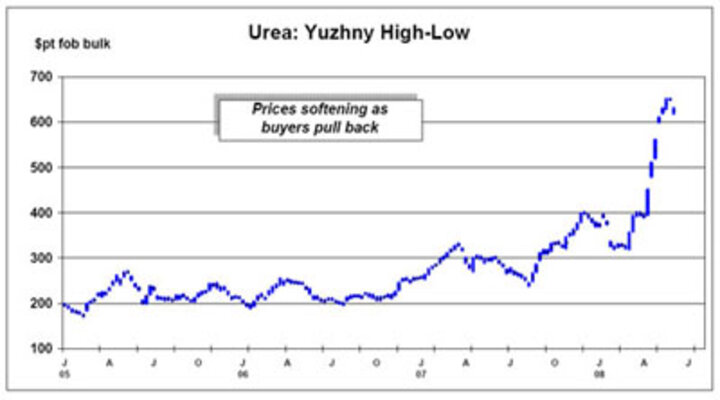June 27, 2008
In Winter Wheat
Wheat harvest is only a few weeks away, but it's time to start thinking about next year's fertilizer needs. We've seen major changes in production costs and wheat prices with wheat prices now two to three times what they were two years ago. Nitrogen prices have doubled and phosphate prices have increased almost four times what they were two years ago.
Fertilizer is truly an international commodity, so what happens in the Middle East, India, China and in former Soviet Union countries like the Ukraine influence local prices. Both urea and phosphate prices on world markets have come down recently (Figures 1, 2 and 3) but are still at historic highs.
Anhydrous ammonia prices at world and U.S. gulf ports has declined due to limited world demand at this time including wet conditions through much of the Corn Belt.
Because of the volatility in price, producers should continually check with fertilizer suppliers for pricing options. In the past the normal $0.10 to $0.15 per pound differential between dry and liquid nitrogen sources versus ammonia was not a major cost factor when applying nitrogen rates of 50 to 60 pounds per acre for dryland wheat. That difference is now in the range of $0.25 to $0.30 per pound of nitrogen and should be considered when selecting your nitrogen source.
Let Soil Tests be Your Guide
The best way to determine fertilizer requirements for wheat is with a soil test. Guidelines for taking a good soil sample are provided in the NebGuide Guidelines for Soil Sampling (G1740).
Soil samples for pH, phosphorus, potassium, and micronutrients should be taken every three to five years as these values do not change rapidly even with fertilization. The topsoil sample should be taken from the 0- to 8-inch depth.
This year has again produced rainfall extremes across Nebraska. West central to eastern Nebraska had above normal rainfall this spring whereas much of the Panhandle is still below normal. Because soil nitrate is very mobile, sampling should occur before the crop is planted. Soil samples for nitrate should also be taken to at least a three-foot depth.
Estimating Fertilizer Needs
Historic fertilizer prices that will probably not decline are reasons to determine nutrient needs then do the best job of placement and timing. Information from your soil tests plus fertilizer prices and expected selling price for your wheat are used in the calculation of both nitrogen and phosphorus recommendations(See NebGuides, Fertilizing Winter Wheat I: Nitrogen, Potassium, and Micronutrients , G1460 and Fertilizing Winter Wheat II: Phosphorus, G1461.)
Even though fertilizer prices are high, the higher wheat price suggests that applying nitrogen is still profitable (Table 1) based on a range of current prices for wheat and nitrogen.
| Table 1. Nitrogen fertilizer recommendations for dryland wheat when nitrogen is $0.65 per pound. | ||
| Residual Nitrate |
Wheat price $ per bushel |
|
|
Average ppm nitrate-N in a 3-foot depth |
$6.00 | $9.00 |
| 2 | 70 | 95 |
| 4 | 50 | 75 |
| 6 | 30 | 55 |
| 8 | 0 | 35 |
| 10 | 0 | 15 |
| *Grey bar indicates usual soil test range | ||
Applying phosphate is also still profitable. Nebraska data shows up to a 20 bu/ac increase to applied phosphorus at low soil test phosphorus and up to 10 bu/ac increases for medium phosphorus soils. The most profitable phosphorus rate depends on the source used, wheat and fertilizer prices, soil pH and the application method. Row or dual-applied phosphorus is more efficient than a broadcast application and may be the best strategy during times of high prices. The lower rates of row or band-applied phosphorus, however, will not build soil phosphorus levels when compared to the higher recommended broadcast rates.
Knife (dual) placement and seed applied phosphorus perform equally at optimum seeding dates. If the seeding date is delayed or growing conditions prevent or delay root growth to the dual placement band, seed placement is the preferred application method. Dual placed phosphorus can be readily applied with standard ammonia applicators equipped to dispense 10-34-0. The normal ammonia application depth (4 to 6 inches) is also optimum. Knife spacing should not be more than 15 inches.
Gary Hergert
Extension Soils Specialist
Panhandle REC, Scottsbluff



